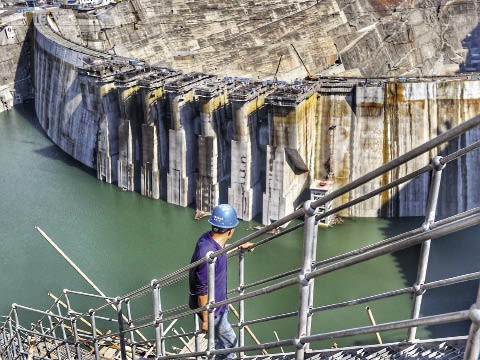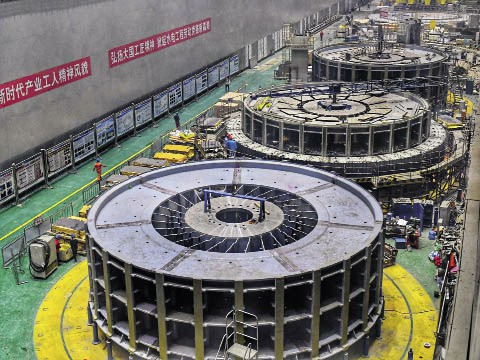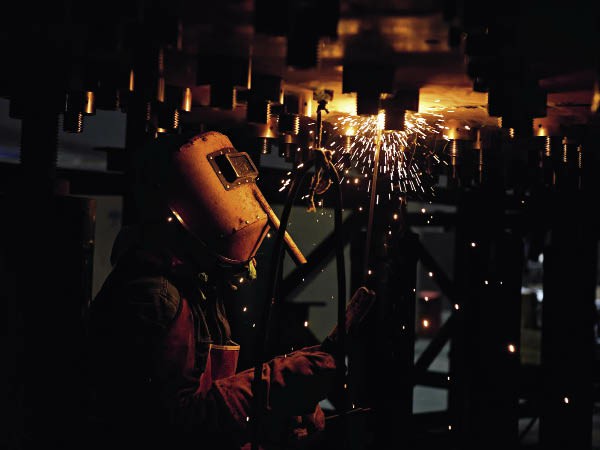The Jinsha River looks even clearer and more turquoise glittering under the summer sun. Xu Guocong, a 38-year-old woman living by the river, goes to work every morning after sending her son to school. She works as a public area attendant for an electromechanical project in Baihetan Hydropower Station that was funded by China Energy Group. Her husband is a security guard for the same project. The couple have stable monthly incomes from their jobs and their work is located very near their home.
Earlier this year, Xu’s family moved to their current 300-square-meter new house that was built with government funding as part of the government’s efforts to help lift her and her fellow villagers out of poverty. “We now live in a comfortable house and enjoy a well-off life,” said Xu who comes from Dazhai Town in Shaotong, southwest China’s Yunnan Province. “It’s a long-time dream coming true,” she then added.

A worker looking over at the ultra-high double-curved arch dam of Baihetan Hydropower Station.
“We Will Continue Working toward a Better Life”
Xu’s family used to live in a mountainous village. “The road was narrow and dangerous. It took two or even three hours to send our children to school in town,” recalled Xu, who had dreamed of having a house in the town for a long time.
Several years ago, she heard her late grandparents talk about the news that a dam and hydropower station would be built on the Jinsha River. “My grandparents told me that our life would get better after the construction on the dam began,” Xu said.
In August of 2017, the ground was broken at the construction site of the Baihetan Hydropower Station. It was the second largest hydropower station under construction worldwide. “After more than 10 years of research, surveying, and designing, and more than six years of preparations, the construction of two million-kilowatt hydropower stations, the Baihetan Hydropower Station and Wudongde Hydropower Station, are now in full swing,” read the national broadcaster’s prime-time news back then. “Our family watched that broadcast together,” Xu said.
After the construction began, Dazhai Town, which previously only came alive during festivals, began to come to life. “The road was fixed. There were more vehicles and unfamiliar faces and new things began to pour in,” Xu recalled.
“Good news came one after another. First, we moved into our new house, and then my husband and I got jobs working in the hydropower station. Now a rural housewife like me could have a stable income,” Xu said. It never occurred to her that a power station could bring such tremendous changes to her life within a matter of several years. “We no longer need to worry about food, clothing or housing anymore. The school for my children is located just 10 minutes away by foot. I’m so happy about my life now, and we will continue working toward a better life.”

The generator room on the right bank of Baihetan Hydropower Station.
“I Want to Be the Pride of My Daughter”
Early on the morning of Mother’s Day this year, Zhang Dongmei received a message from her daughter who was several thousand kilometers away from her. “Dear mom, happy Mother’s Day! Take care of yourself and remember you will always be our pride,” the message read. After reading the message, Zhang burst into tears.
Zhang is the deputy secretary of the Party branch of Baihetan electromechanical project. “Both of my parents dedicated their entire lives to hydropower stations. I learned from them that work always comes first,” she said. But even though she is a dedicated career woman, she also feels indebted to her family and daughter for supporting her working long hours away from home.
Over the past several years, Zhang has spent lots of time away from home at construction sites.
The one-million-kilowatt giant water-turbine generator set at the Baihetan Hydropower Station was designed, manufactured, and installed with domestic technologies, and has the world’s largest unit power generation capacity. “I’m honored to work here,” Zhang said proudly. Thanks to her outstanding performance, Zhang was presented with the national role model award for female worker this year.
“I have participated in the construction and installation of 35 giant generator units, and I’m so lucky to be able to witness the technological advances of our country in the area of hydropower generation,” Zhang said. The first million-kilowatt generator set in Baihetan went into service days before July 1, the 100th anniversary of the CPC’s founding. “It was an exciting moment.”
Wearing a safety helmet and work clothes, Zhang spends most of her days on construction sites filled with rumbling machines. “I want to be the pride of my daughter,” she said.

A welder at work.
The Highlight Moment
In early September of 2020, Mei Lin, a bridge crane operator for the project, was assigned to hoist a rotor for the million-kilowatt generator set. “I was excited and nervous, as I was about to hoist the rotor for the world’s largest generator set,” Mei recalled. “Not every crane operator has the opportunity to do such a task.”
The rotor Mei worked on is the core part of the generator set. It measures 2,300 tons in weight, 16.5 meters in diameter, and is four meters high. It can only be hoisted when two bridge cranes both having a capacity of 1,300 tons work in tandem.
“It was only 42 millimeters between the giant rotor and stator. I need to be very precise and steady when I am operating it. It is a big test for me,” Mei said. To guarantee the success of the hoisting operation, she participated in drawing up the plans for the task and did a thorough check of the bridge cranes.
On the operation day, Mei moved the gears and levers with confidence and ease. She hoisted the giant rotor close to 10 meters in the air, then crossed over five pits and moved it into position at Pit No. 14 after moving horizontally for 257 meters.
“After it was moved into position, I had to make some slight adjustments by moving it one millimeter, a distance which is not obvious to the naked eye,” Mei said. She needed to hear the opening of the band-type brake and then immediately bring back the lever. In this way, she can make sure the 2,300-ton rotor can be moved within one millimeter. This precision of movement was only made possible after she spent 9,490 days working on the bridge crane.
After more than one hour, Mei managed to finish the task successfully. “It is a life-time honor to move into position the rotor for the world’s largest generator unit independently developed by China. That was also the highlight moment of all Chinese who have contributed to the hydropower cause,” Mei said.
“I have put 16 rotors into position during my years of working,” said Mei. Throughout her career, she has dedicated her time and energy to bridge crane operation and made herself a master of the profession.
Baihetan became the world’s second largest hydropower station next to the Three Gorges after it went into operation in July this year. Within one year, all of its 16 generator sets will be put into use, at which time, it will form the world’s largest clean energy generation base together with Wudongde Hydropower Station in the upper reaches of the Jinsha River and Xiluodu and Xiangjiaba hydropower stations in the lower reaches. The annual electricity generated by the base is expected to reach 200 billion kWh.